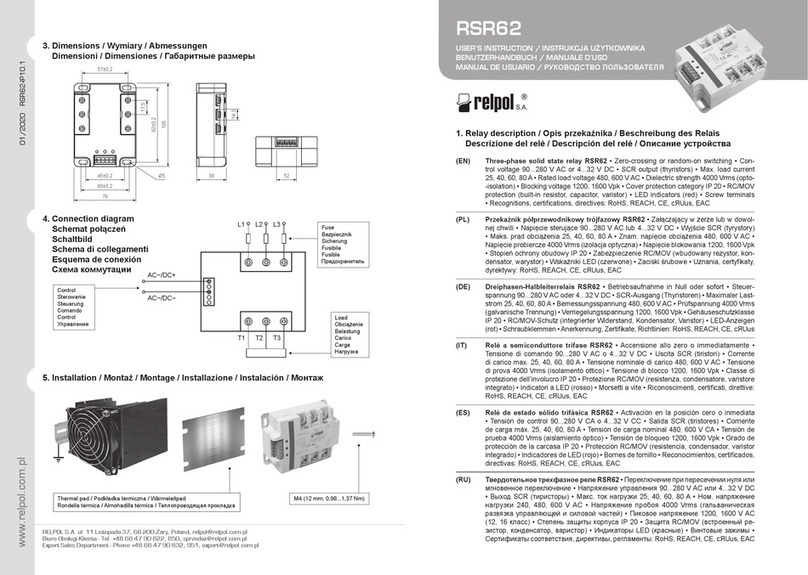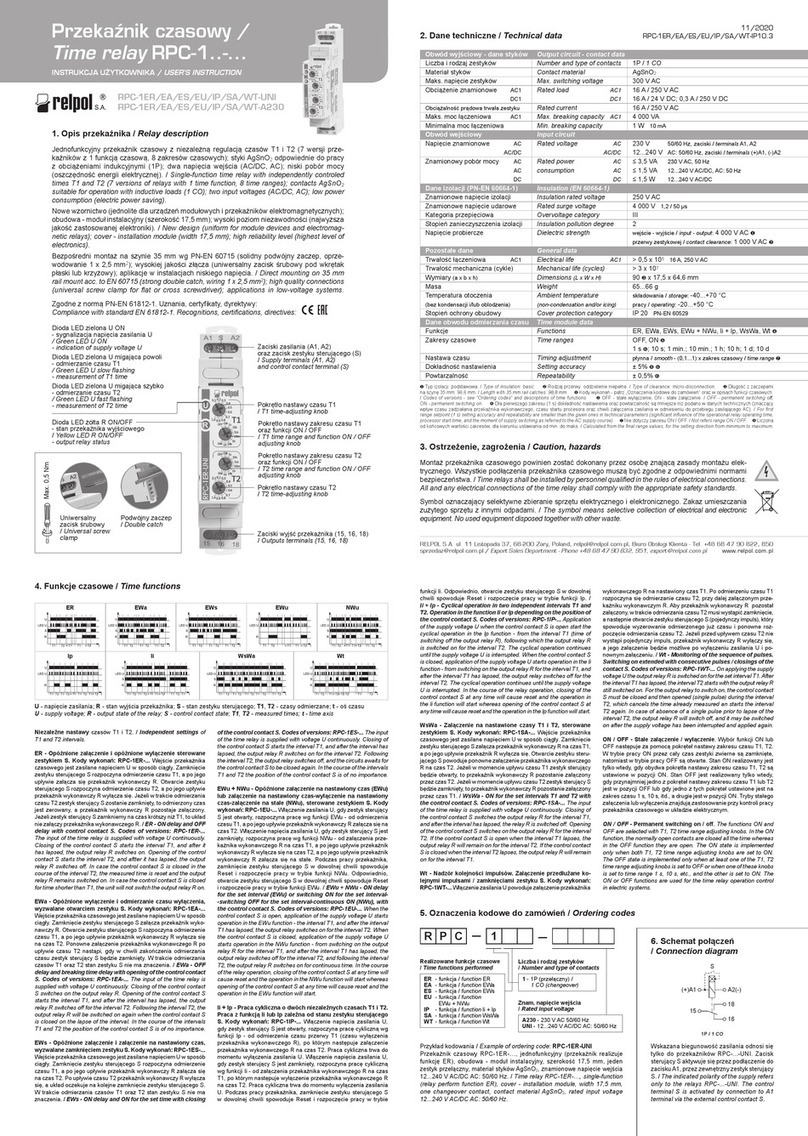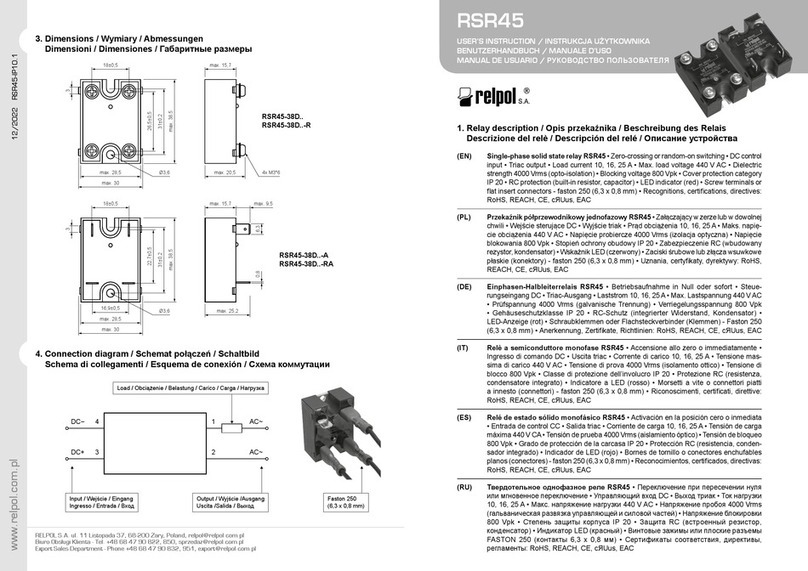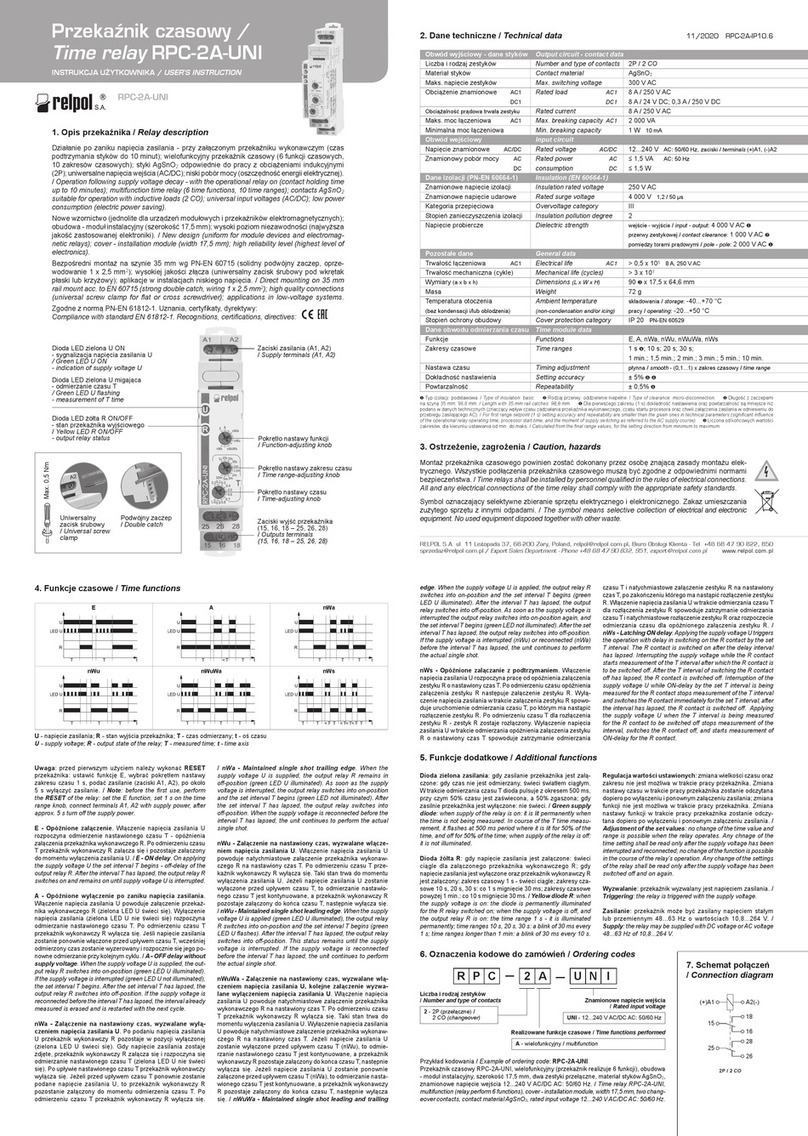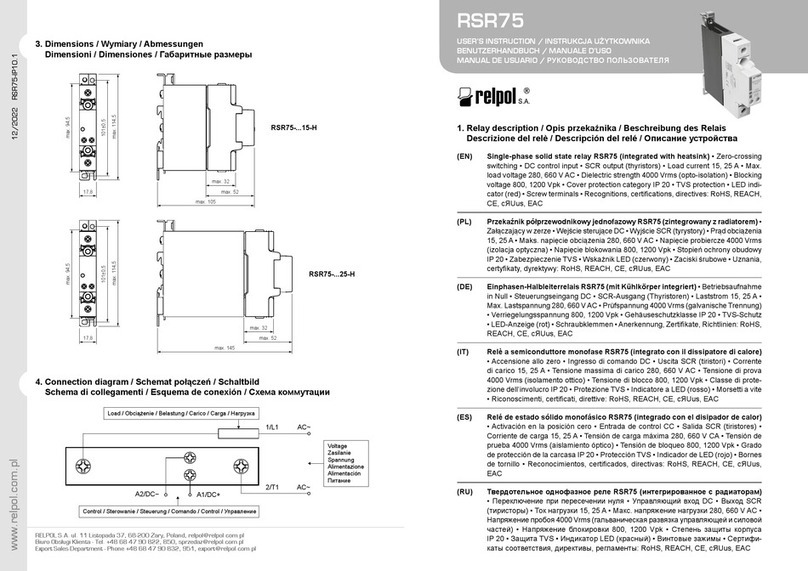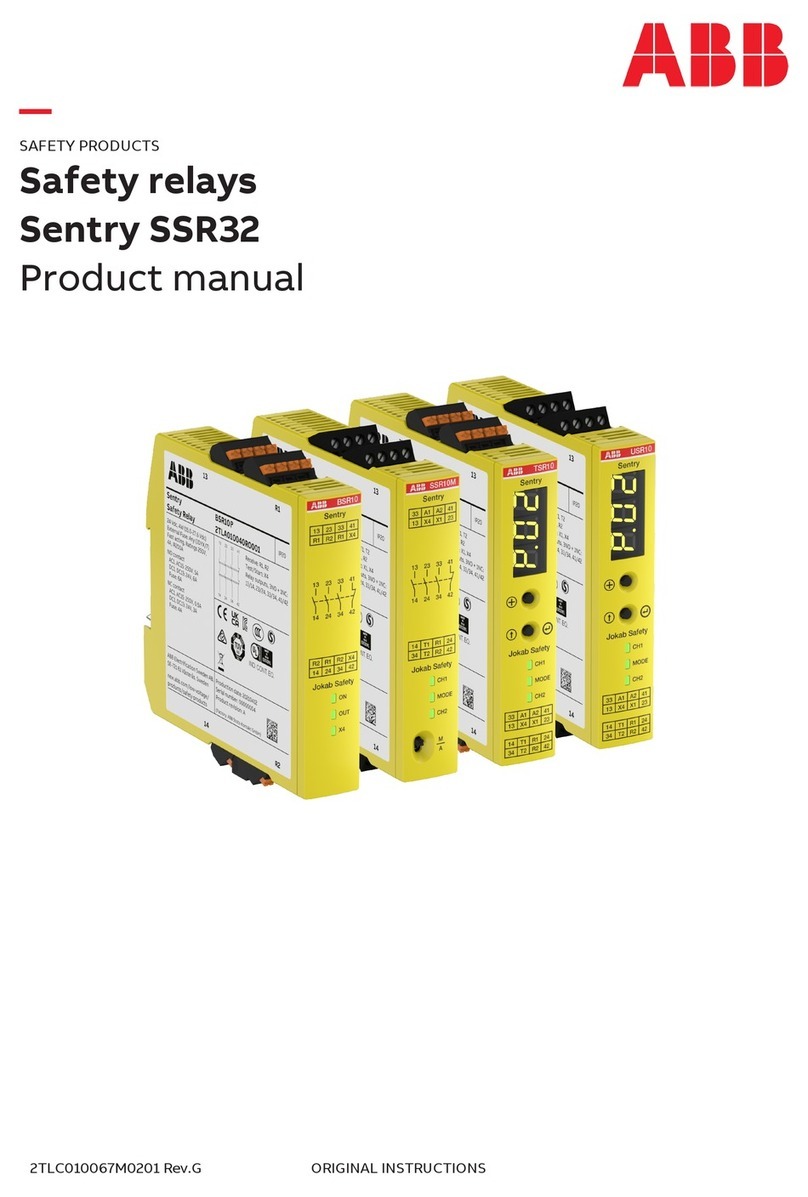
(EN) In the solid state relay, the voltages on its connections are dangerous
for human life. Touching live parts may result in electrocution!
Turn o the device/installation in which you are mounting the relay, and
protect the device/installation against accidental turning on. Prior to mo-
unting, make sure there is no voltage in the device/installation. Remember
to release the electrostatic loads before you touch the relay. Connect
a short-cut protection and safeguarding!
Follow the rules and recommendations included in the user’s manual.
The relay should be mounted by a person who knows the principles of
mounting electric devices. Remember that the installed devices must be
protected against accidental turning on.
A solid state relay and the radiator heat up during their operation! You
should not touch the surface of the radiator or the relay when the supply is
on. After the supply has been turned o, you should wait until the radiator
and the relay are cooled to a safe temperature.
Notes on safe operation
• A solid state relay should be mounted by a person who knows the rules
of safe mounting.
• All the connections of a solid state relay must comply with the appli cable
safety standards.
• The supply installation parameters should not exceed the tolerance limits
provided in the technical data of the relay.
• When you use the relay in circuits where emergency stop is required,
dene the operation of the circuit during the emergency stop switching on
and o in order to avoid unforeseeable situations, e.g. uncontrolled start
of the automation system.
• Determine correctness of the system in response to switching o the
supply voltage and to switching it on again.
Installation order
1. Preparation and protection of the installation place. 2. Mechanical
mounting. 3. Connecting the wires (input/output/supply).
Thermalconditionsandcoolingoftherelay
Do not block the air circulation through the relay, and provide good ven-
tilation in the control cabinets in which relays are mounted. The internal
parts of the solid state relay are sensitive to heat.
Always use thermal pads and radiators, if necessary. Always take care
of the surfaces of the contact between the materials (relay/pad/radiator).
Always use radiators made from materials of low thermal resistance.
Follow the catalog recommendations concerning the parameters of the
radiator you use.
Tighten the screws correctly, with the appropriate toque, and remember that
lashes on wires may cause extra heat emission which may result in re.
Use wires of the appropriate diameter and with no damages on the insu-
lation. Remember that an incorrectly chosen wire may cause extra heat
emission which may result in re.
(PL) W przekaźniku półprzewodnikowym na jego podłączeniach występują
napięcia niebezpieczne dla życia ludzkiego. Dotykanie części znajdujących
się pod napięciem grozi porażeniem prądem elektrycznym!
Wyłącz urządzenie/instalację, w którym montujesz przekaźnik pół prze-
wodnikowy oraz zabezpiecz urządzenie/instalację przed przypadkowym
załączeniem. Przed montażem upewnij się, że żadne napięcie nie wy-
stępuje w urządzeniu/instalacji. Pamiętaj o odprowadzeniu ładunków
elektrostatycznych przed dotknięciem przekaźnika. Koniecznie podłącz
zabezpieczenia przeciwzwarciowe i ochronne!
Przestrzegaj zasad i zaleceń zawartych w instrukcji użytkownika. Montaż
przekaźnika powinien zostać dokonany przez osobę znającą zasady
montażu elektrycznego. Pamiętaj, że zainstalowane urzą dzenia muszą
być zabezpieczone przed nieumyślnym uruchomieniem.
Przekaźnik półprzewodnikowy i radiator nagrzewają się podczas pracy! Nie
należy dotykać powierzchni radiatora oraz przekaźnika przy włączonym
zasilaniu. Po wyłączeniu zasilania należy odczekać, aż radiator oraz
przekaźnik zostaną schłodzone do bezpiecznej temperatury.
Uwagidotyczącebezpiecznegoużytkowania
• Montaż przekaźnika półprzewodnikowego powinien zostać dokonany
przez osobę znającą zasady montażu elektrycznego.
• Wszystkie podłączenia przekaźnika półprzewodnikowego muszą być
zgodne z odpowiednimi normami bezpieczeństwa.
• Parametry sieci zasilającej nie powinny przekraczać granicznych progów
tolerancji przedstawionych w danych technicznych przekaźnika.
• Jeżeli stosujesz przekaźnik w układach, gdzie konieczne jest zatrzymanie
awaryjne, określ zachowanie się układu w czasie zadziałania i odbloko-
wywania systemu zatrzymania awaryjnego, w celu uniknięcia nieprzewi-
dzianych sytuacji, np. niekontrolowanego startu systemu automatyki.
• Określ poprawność zachowania układu w reakcji na wyłączenie napięcia
zasilającego oraz na jego ponowne załączenie.
Kolejnośćinstalacji
1. Przygotowanie i zabezpieczenie miejsca instalacji. 2. Montaż mecha-
niczny. 3. Podłączenie przewodów (wejście/wyjście/zasilanie).
Warunkitermiczneichłodzenieprzekaźnika
Nie blokuj przepływu powietrza przez przekaźnik oraz stosuj dobrą wenty-
lację w szafach sterowniczych, w których zamontowane są przekaźniki.
Elementy wewnętrzne przekaźnika półprzewodnikowego są wrażliwe
na ciepło.
Koniecznie używaj podkładek termicznych oraz, jeśli jest taka potrzeba,
radiatorów. Zawsze dbaj o powierzchnie styku materiałów (przekaźnik/
podkładka/radiator).
Używaj zawsze radiatorów z materiałów o małym oporze cieplnym. Stosuj
się do katalogowych zaleceń dotyczących parametrów stosowanego
radiatora.
Dokręcaj śruby prawidłowo, z odpowiednim momentem dokręcania, pamię-
tając, że luzy na przewodach mogą spowodować dodatkowo wydzielenie
się ciepła, które może doprowadzić do powstania ognia.
Używaj przewodów o odpowiedniej średnicy, z nieuszkodzoną izolacją.
Pamiętaj, że źle dobrany przewód może spowodować dodatkowe wy-
dzielenie się na nim ciepła, a w konsekwencji, może doprowadzić do
powstania ognia.
(DE) An den Verbindungen des Halbleiterrelais treten lebensgefährliche
Spannungen auf. Das Berühren spannungsführender Teile kann zu einem
elektrischen Schlag führen!
Schalten Sie das Gerät/die Anlage, in der Sie das Halbleiterrelais mon-
tieren, aus und schützen Sie das Gerät/die Anlage vor unbeabsichtigtem
Einschalten. Vergewissern Sie sich vor der Montage, dass keine Spannung
im Gerät/der Installation vorliegt. Denken Sie daran, elektrostatische
Ladungen zu entfernen, bevor Sie das Relais berühren. Kurzschluss- und
Schutzeinrichtungen bzw. -sicherungen unbedingt anschließen!
Befolgen Sie die Regeln und Anweisungen in der Bedienungsanleitung.
Das Relais sollte von einer Person installiert werden, die mit den Regeln
der Elektroinstallation vertraut ist. Beachten Sie, dass installierte Geräte
vor unbeabsichtigtem Einschalten geschützt werden müssen.
Das Halbleiterrelais und der Kühlkörper erwärmen sich während des
Betriebs! Berühren Sie die Oberäche des Kühlkörpers oder des Relais
nicht, wenn das Gerät ans Netz angeschlossen ist. Warten Sie nach dem
Ausschalten der Stromversorgung bis der Kühlkörper und das Relais auf
eine sichere Temperatur abgekühlt sind.
HinweisezumsicherenGebrauch
• Das Halbleiterrelais ist nur von autorisiertem Fachpersonal zu installieren.
• Alle Anschlüsse des Halbleiterrelais müssen den einschlägigen Sicher-
heitsnormen entsprechen.
• Die Parameter der Netzversorgung dürfen die in den technischen Daten
des Relais angegebenen Toleranzgrenzen nicht überschreiten.
• Wenn Sie das Relais in Systemen verwenden, in denen eine Not-Aus-
-Funktion erforderlich ist, geben Sie das Verhalten des Systems während
des Not-Aus und der Entriegelungszeit an, um unvorhergesehene
Situationen zu vermeiden, z.B. unkontrolliertes Starten des Automati-
sierungssystems.
• Bestimmen Sie die Korrektheit des Systemverhaltens als Reaktion auf
die Abschaltung der Versorgungsspannung und ihre erneute Inbetrieb-
nahme.
Installationsreihenfolge
1. Vorbereitung und Schutz des Aufstellungsortes. 2. Mechanische
Montage. 3. Anschluss der Leitungen (Eingang/Ausgang/Einspeisung).
ThermischeBedingungenundKühlungdesRelais
Blockieren Sie den Luftstrom durch das Relais nicht und sorgen Sie für
eine gute Belüftung in den Schaltschränken, in denen die Relais installiert
sind. Die internen Komponenten des Halbleiterrelais sind wärmeemp-
ndlich. Verwenden Sie unbedingt Wärmeleitpads und ggf. Kühlkörper.
Achten Sie immer auf den Zustand der Kontaktächen der Materialien
(Relais/Pad/Kühler).
Verwenden Sie immer Kühlkörper aus Materialien mit geringem Wärme-
widerstand. Befolgen Sie die Katalog-Empfehlungen zu den Parametern
des verwendeten Kühlkörpers.
Ziehen Sie die Schrauben mit dem richtigen Drehmoment richtig an, wobei
zu beachten ist, dass eine lose Leitung zusätzliche Wärmeentwicklung
und in Konsequenz dessen Brand verursachen kann.
Verwenden Sie Drähte mit einem passenden Durchmesser und unbe-
schädigter Isolierung. Denken Sie daran, dass ein unpassendes Kabel
zusätzliche Wärmeentwicklung und in Konsequenz dessen Brand
verursachen kann.
(IT) Il relè a semiconduttore è collegato con tensioni pericolose per la
vita umana. Il contatto con le parti sotto tensione può provocare scosse
elettriche!
Spegnere l’apparecchio/l’installazione in cui si monta il relè a semicon-
duttore e proteggere l’apparecchio/l’installazione contro un azionamento
accidentale. Prima dell’installazione assicurarsi che non vi sia tensione
nell’apparecchio/nell’installazione. Ricordarsi di scaricare le cariche elet-
trostatiche prima di toccare il relè. È indispensabile collegare i dispositivi
di sicurezza e di protezione contro i cortocircuiti!
Rispettare le regole e le istruzioni contenute nel manuale d’uso. Il relè deve
essere installato da una persona che abbia familiarità con le prescrizioni di
installazione elettrica. Ricordare che i dispositivi installati devono essere
protetti contro un avviamento involontario.
Il relè a semiconduttore e il dissipatore di calore si riscaldano durante il
funzionamento! Non toccare la supercie del dissipatore di calore o del
relè quando l’alimentazione è collegata. Dopo aver spento l’alimentazione,
attendere che il dissipatore di calore e il relè siano rareddati ad una
temperatura di sicurezza.
Noteperunusosicuro
• Il relè a semiconduttore deve essere installato da una persona che abbia
familiarità con le prescrizioni di installazione elettrica.
• Tutti i collegamenti del relè semiconduttore devono essere conformi alle
relative norme di sicurezza.
• I parametri della rete di alimentazione non devono superare i limiti di
tolleranza specicati nei dati tecnici del relè.
• Se si utilizza il relè nei sistemi in cui è necessario un arresto di emergenza,
specicare il comportamento del sistema durante l’arresto di emergenza e
sbloccare il tempo di sblocco per evitare situazioni impreviste, ad esempio
un avvio incontrollato del sistema di automazione.
• Determinare la regolarità del comportamento del sistema in risposta
alla disattivazione della tensione di alimentazione e alla sua riattivazione.
Sequenzadiinstallazione
1. Preparazione e protezione del luogo di installazione. 2. Installazione
meccanica. 3. Collegamento dei cavi (ingresso/uscita/alimentazione).
Condizionitermicheerareddamentodelrelè
Non bloccare il usso d’aria attraverso il relè e utilizzare una buona
ventilazione negli armadi di comando in cui sono installato i relè. I com-
ponenti interni di un relè a semiconduttore sono sensibili al calore.
È essenziale utilizzare rondelle termiche e, se necessario, dissipatori di
calore. Prestare sempre attenzione alle superci di contatto dei materiali
(relè/rondella/dissipatore di calore).
Utilizzare sempre dissipatori di calore realizzati in materiali a bassa re-
sistenza al calore. Seguire le raccomandazioni del catalogo per quanto
riguarda i parametri del dissipatore di calore utilizzato.
Serrare correttamente le viti con la coppia di serraggio corretta, tenendo
presente che il lo allentato può causare un’ulteriore generazione di calore
e di conseguenza provocare incendi.
Utilizzare li di diametro adeguato e con isolamento integro. Ricordare che
un cavo selezionato erroneamente può causare un’ulteriore generazione
di calore su di esso e di conseguenza provocare incendi.
(ES) En las conexiones del relé de estado sólido se dan tensiones pe-
ligrosas para la vida humana. ¡El contacto con elementos bajo tensión
puede dar lugar a un choque eléctrico!
Apague el equipo / la instalación en donde se instale el relé de estado
sólido y proteja el equipo / la instalación contra una activación accidental.
Antes de proceder al montaje, asegúrese de que no haya tensión en el
aparato / la instalación. Recuerde desviar las cargas estáticas antes de
tocar el relé. ¡Es imprescindible conectar los elementos de prevención de
cortocircuitos y los equipos de protección pertinentes!
Siga las reglas e instrucciones del manual de usuario. La instalación
del relé se debe encargar a una persona que conozca el procedimiento
a seguir a la hora de realizar instalaciones eléctricas. Recuerde que
los dispositivos instalados deben estar protegidos contra la puesta en
marcha involuntaria.
¡El relé de estado sólido y el disipador de calor se calientan durante el
funcionamiento! No toque la supercie del disipador de calor o del relé
mientras esté conectada la alimentación eléctrica. Después de desco-
nectar la alimentación eléctrica, espere hasta que el disipador de calor
y el relé se enfríen a una temperatura segura.
Indicacionesparaunusoseguro
• La instalación del relé de estado sólido se debe encargar a una persona
que conozca el procedimiento a seguir a la hora de realizar instalaciones
eléctricas.
• Todas las conexiones del relé de estado sólido deben cumplir las normas
de seguridad pertinentes.
• Ninguno de los parámetros de la alimentación de red debe superar los
límites de tolerancia especicados en la cha técnica del relé.
• Si utiliza el relé en sistemas en los que sea necesaria una parada
de emergencia, especique el comportamiento del sistema durante la
activación y el desbloqueo del sistema de parada de emergencia para
evitar situaciones imprevistas, tales como el arranque incontrolado del
sistema automático.
• Especique el comportamiento correcto del sistema en respuesta
a la desconexión de la tensión de alimentación y su conexión de nuevo.
Orden de las tareas de instalación
1. Preparación y protección del lugar de instalación. 2. Montaje mecánico.
3. Conexión de cableado (entrada/salida/alimentación).
Condiciones térmicas y enfriamiento del relé
No bloquee el ujo de aire a través del relé y garantice una buena ven-
tilación en los armarios de control en los que se instalado los relés. Los
componentes internos del relé de estado sólido son sensibles al calor.
Asegúrese de usar almohadillas térmicas y, si es necesario, disipadores
de calor. Siempre mantenga las supercies de contacto de los materiales
(relé/almohadilla/disipador) en buen estado.
Siempre utilice disipadores de calor fabricados en materiales de baja
resistencia térmica. Siga las recomendaciones del catálogo con respecto
a los parámetros del disipador de calor utilizado.
Atornille adecuadamente los tornillos, con el par de apriete correcto,
teniendo en cuenta que los cables sueltos pueden generar calor adicional,
lo cual puede dar lugar a un incendio.
Utilice alambres con el diámetro correcto y aislamiento que no presente
daños. Recuerde que un cable incorrectamente seleccionado puede
causar una generación adicional de calor y, como consecuencia, puede
provocar un incendio.
(RU) Клеммы твердотельного реле находятся под напряжением,
опасным для жизни человека. Прикосновение к токоведущим частям
может привести к поражению электрическим током!
Выключите устройство/установку, в которой установлено твердо-
тельное реле и обеспечьте безопасность устройства/установки
от случайного включения. Перед монтажем убедитесь, что в
устрой стве/установке отсутствует напряжение. Не забудьте снять
электростатический заряд, прежде чем прикасаться к реле. Обя-
зательно подключайте реле через устройство защиты от КЗ!
Следуйте правилам и рекомендациям в руководстве пользователя.
Установка реле должна производиться квалифицированными
специалистами, согласно действующим нормам и правилам.
Помните, что устанавливаемые устройства должны быть защищены
от непреднамеренного запуска в момент монтажа.
Твердотельное реле и радиатор нагреваются во время работы!
Не прикасайтесь к поверхности радиатора и реле при включенном
питании. После выключения питания подождите, пока радиатор
и реле охладятся до безопасной температуры.
Примечанияпобезопаснойэксплуатации
• Монтаж твердотельного реле должен выполняться квалифици-
рованными специалистами, знающими принципы электрического
монтажа, согласно действующим нормам и правилам.
• Все подключения твердотельного реле должны соответствовать
действующим стандартам безопасности.
• Параметры питающей сети не должны превышать максимально
допустимых пределов, указанных в технических данных реле.
• Если вы используете реле в системах с автоматическим включением
резерва (АВР) то необходимо убедиться, что данная система раз-
бло кирована и не даст неконтролируемую команду на АВР при
отключении напряжения питания.
• Проверьте правильность поведения системы при отключении
напряжения питания и его повторном включении.
Порядокустановки
1. Подготовка и обеспечение безопасности места установки. 2.
Механический монтаж. 3. Подключение проводов (вход/выход/
питание).
Тепловойрежимиохлаждениереле
Не блокируйте поток воздуха через реле и используйте хорошую
вентиляцию в шкафах управления, в которых установлены реле.
Внутренние компоненты твердотельного реле чувствительны
к теплу.
Обязательно используйте теплопроводящие прокладки и при необ-
ходимости, радиаторы. Всегда заботьтесь о поверхностях контакта
с материалом (реле / прокладка / радиатор).
Всегда используйте радиаторы из материалов с низкой термостой-
костью. Следуйте рекомендациям каталога относительно параметров
используемого радиатора.
Правильно затяните винты с соответствующим моментом затяжки,
учитывая, что ослабление проводов может вызвать дополнительный
нагрев, который может привести к возгоранию.
Используйте кабели соответствующего диаметра с неповрежденной
изоляцией. Помните, что неправильно выбранный кабель может
вызвать дополнительное нагревание на нем и как следствие, привести
как к повреждению самого реле, так и возможному возгоранию.
2.Caution,hazards/Ostrzeżenie,zagrożenia/Warnung,Gefahren/Avvertimento,pericoli/Advertencia,peligros/Предупреждения,рекомендации
